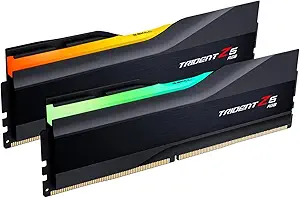G.SKILL Trident Z5 RGB DDR5 32GB (2x16GB) 7200MHz CL34

The G.SKILL Trident Z5 RGB Series is a high-performance DDR5 RAM kit featuring a total capacity of 32GB, divided into two 16GB modules. With a blazing frequency of 7200MT/s and a CL34 latency, this memory is designed to deliver exceptional performance for Intel systems.
Popularity: Low
Performance:
Specifications:
Model: G.SKILL Trident Z5 RGB DDR5 32GB (2x16GB) 7200MHz CL34
Type: DDR5
Capacity: 32.0
OC Profile: Intel XMP 3.0
Tested Speed: 7200 MT/s
Tested Latency: 34-45-45-115
Tested Voltage: 1.40V
Default Speed: 4800 MT/s
Default Latency:
Default Voltage: 1.10V
Heat Spreader:
LED Lighting:
Manufacturer Page: Link
Review
The advancement of DDR5 technology has marked a significant evolution in memory performance, and the G.SKILL Trident Z5 RGB DDR5 32GB (2x16GB) 7200MHz CL34 is an exemplar of this progression. With its high-frequency capabilities and low CAS latency, this RAM kit is designed to cater to the needs of high-performance Intel systems. But what truly sets it apart?
Specifications and Build Quality
The G.SKILL Trident Z5 RGB DDR5 comes as a dual-channel kit, each module packing 16GB, bringing the total capacity to 32GB. It boasts a remarkable tested speed of 7200 MT/s and a CAS latency of 34-45-45-115, supported by a voltage of 1.40V. More notably, the memory implements Hynix A-die chips which enable it to reach such high frequencies, a step above the earlier generations utilizing Hynix M-die chips (PC Gamer). These chips contribute to its classification as second-generation DDR5 memory.
Aesthetic and RGB Lighting
Visually, the Trident Z5 continues G.SKILL's tradition of stylishly designed modules. The RAM features a sleek matte black heat spreader with RGB lighting that is characteristically understated yet sophisticated. It offers a more muted glow as compared to its contemporaries, which some users may find appealing due to its non-intrusive elegance. RGB customization is facilitated either via the G.SKILL Lighting Control app or third-party motherboard software (LDLC). This RGB implementation is a welcome addition, enhancing not only the visual appeal but also providing a user-friendly interface for color customization.
Performance and Benchmark Analysis
The performance of the G.SKILL Trident Z5 RGB DDR5 is laudable. Its high frequency is palpable in memory-intensive tasks like file compression and video encoding, where it delivers noticeable improvements. While synthetic benchmarks in AIDA64 primarily serve a comparative purpose, they highlight the kit's superiority over slower alternatives (PC Gamer).
For gamers, the RAM shows promising results but only under specific conditions. It unlocked increased FPS in CPU-intensive scenarios in games such as Far Cry 6 and even benefitted graphically demanding titles like Cyberpunk 2077, proving the boon of higher memory speeds when paired appropriately (PC Gamer). However, it is noteworthy that not every game is sensitive to such advanced RAM, with titles like Ghost Recon: Breakpoint showing negligible gains.
Practical Considerations and Overclocking Potential
The question of value versus performance is critical when considering top-tier memory, and the G.SKILL Trident Z5 RGB DDR5 intriguingly brings good value at its price point. For individuals maintaining a system with high-end components like the Intel Core i9 13900K and RTX 4090, this memory offers performance benefits that justify its premium (PC Gamer).
Overclocking is feasible but requires careful handling. The kit achieved DDR5-7600 speeds at increased voltage on a supportive motherboard. Yet, successful overclocking also demands a robust memory controller, underpinning the necessity of a high-caliber platform for enthusiasts wishing to push beyond default settings (PC Gamer).
Conclusion
In summary, the G.SKILL Trident Z5 RGB DDR5 32GB (2x16GB) 7200MHz CL34 is an impressive RAM kit meant for those who possess or seek to build a high-powered system. Its balance between rapid data transfer speeds, aesthetic appeal, and advanced design decisions make it more than a simple component—it stands as a testament to the evolving landscape of PC memory technology.